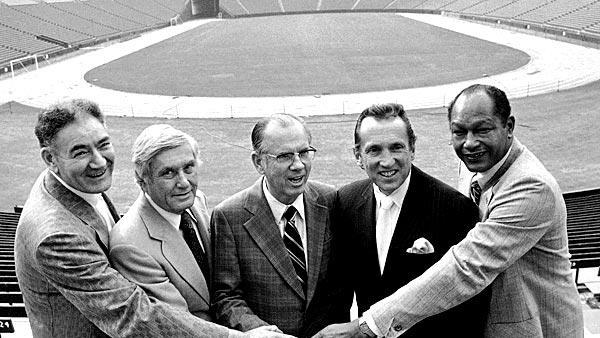The Rams franchise is returning to the Los Angeles Memorial Coliseum to play their first season in L.A. since departing for St. Louis in 1995.
There’s a ton of interesting and important information that seems to get missed when the history of the Los Angeles Rams and NFL football in L.A. are discussed by the mainstream media. One truth is that the Rams have not actually played in Los Angeles since 1979, and were the biggest victims of Al Davis and the Oakland Raiders anti-trust lawsuit victory over the NFL in 1982.
Here’s where the story begins…
1979
On April 2nd 1979, Los Angeles Rams owner Caroll Rosenbloom, a legendary and beloved NFL owner since 1953, dies in a tragic drowning incident. His widow, Georgia Frontiere, inherits 70% of the team and immediately makes headlines by firing her stepson Steve Rosenbloom.
In the 1st season following the death of their owner, the Rams would honor Mr. Rosenbloom by making their only trip to the SuperBowl while in Los Angeles- (a loss to the Pittsburgh Steelers).
Following the 1979 season, the Rams then carried out Mr. Rosenbloom’s plan for the team to semi-relocate from their longtime home in downtown Los Angeles to nearby Anaheim Stadium. For the Rams fanbase in Los Angeles, this was approximately a 45-70 minute drive depending on traffic.
The Los Angeles Metropolitan Area
An important part of the story is understanding the geography of the Los Angeles metropolitan area. The Rams weren’t just moving outside of Los Angeles in the same way that the Detroit Lions for example, played in Pontiac Michigan for many years. Or in the same way that the Patriots play in Foxborough- a 40 minute-drive from Boston. It was different in that Anaheim, and more accurately, Orange County as a whole, had began to distinguish itself as its own self-sustaining sport market.
Present day, the cities of Anaheim and Santa Ana both have populations greater than 325,000. Irvine has a population of 215,000. There are another 5 municipalities in the O.C. with populations greater than 100,000. Orange County as a whole has a modern day population of 3.1 million people. This hugely populous region distinguishes itself as separate from the city of Los Angeles.
An example to illustrate the important difference between the 2 sport markets in metropolitan L.A. can be seen throughout the history of the Los Angeles Angels of Anaheim franchise. Endlessly torn between which of these sport markets they represent, they finally settled on a name that incorporated both.
The agreement the Rams had reached with the NFL prior to finalizing the move to Anaheim, was that all of the Los Angeles metropolitan area, comprising Los Angeles County and Orange County, would remain the territory of the team. This allowed the franchise to make a strategic move to Orange County; close enough that fans from L.A. could still drive to see the Rams play. They were ensured by the League that they would remain the home-team for Los Angeles.
1980
Meanwhile, the brash owner of the Oakland Raiders up in northern California, Al Davis, famously and opportunistically attempted to move the Raiders to the Los Angeles Memorial Coliseum to fill the void left by the L.A. Rams.
The NFL and the NFL owners declined his request because of the agreement made with the Rams. The Rams had been Los Angeles’ team since 1946 and the move out to Anaheim was meant to be purely for the purposes of using a better stadium, and not a relocation in the sense of distancing themselves from their fans in L.A. The Rams did not undergo any re-branding with their logo, uniforms, and colors, and continued their identity as the ‘Los Angeles’ Rams.
A vote by NFL owners regarding the decision to block the Raiders move was 22-0 (5 owners chose not to vote).
In my opinion the NFL actually had several good reasons to block the Raiders’ move. Firstly, the agreement with the Rams should have trumped everything. The Rams would not have moved to Anaheim if they had known it would be possible for another team to take over their long-time home stadium in downtown L.A.
Secondly, and also of great importance, the Oakland Raiders had become one of the NFL’s premiere franchises at that time. Their success was truly remarkable:
- Expansion franchise for the Inaugural AFL Season in 1960.
- At the time they filed for relocation in 1980, they had not had a losing season since 1964.
- 1967- Won the AFL Championship and lost in SuperBowl II
- Won the SuperBowl in 1976.
- Had been to the AFL/AFC Championship Game another 7 times! (1968, 1969, 1970, 1973, 1974, 1975, 1977).
They had sustained a dynasty of winning for 15 years in Oakland. It’s understandable why the NFL would try and block any move they attempted, especially one into Los Angeles.

